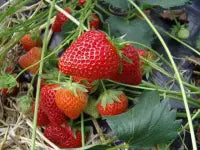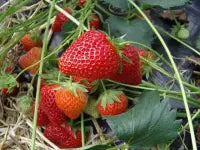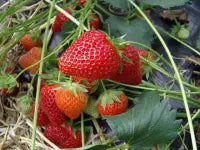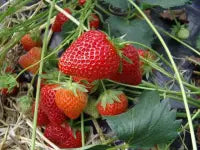Our Charlotte Strawberry plants at producer prices
Buy now and get it delivered when you're ready to plant
-
Charlotte Frigo A++ Strawberry Plant
Regular price €0,36 EURRegular priceUnit price / per -
Charlotte Frigo A+ Strawberry Plant
Regular price €0,30 EURRegular priceUnit price / per -
Charlotte Frigo A Strawberry Plant
Regular price €0,26 EURRegular priceUnit price / per -
Charlotte Frigo A Strawberry Plant
Regular price €0,26 EURRegular priceUnit price / per
Collapsible content
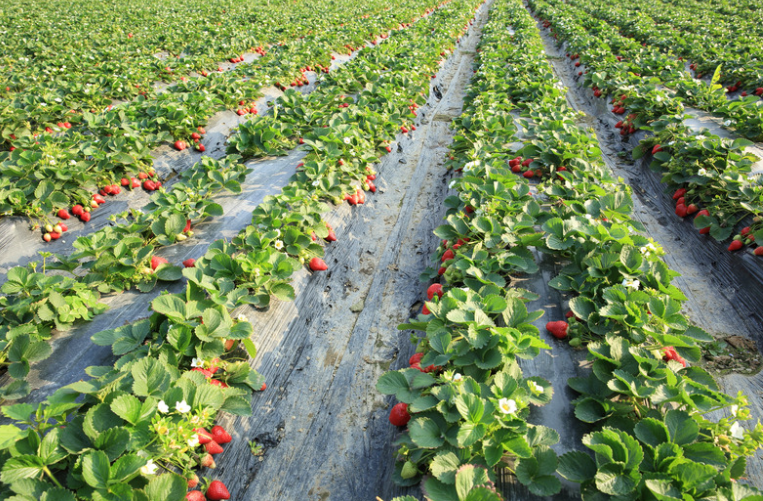
Strawberry Plant Buying Guide: What Type of Plants? For What Market Opportunity?
Which format should you choose: refrigerated, fresh, tray-plants, waiting bed, or plugs? Compare yields, costs, and harvest times at a glance.
Download the PDF guide (13 pages)
Why read this guide?
- Comparison tables: yield (300–600 g/plant), cost & labor.
- Reservation/delivery calendar for each format.
- Minimum order: 20 to 1,000 plants depending on the type.
- Full-field vs. above-ground case studies to maximize margin.
Overview of the 5 professional formats
Detailed comparison of formats
| Format | Yield (g/plant) |
Harvest time | Min. order | Average cost |
|---|---|---|---|---|
| Fridge | 250 – 400 | 120 days | 20 plants | 0.20 – 0.45 € |
| Costs | 280 – 420 | 140 days | 200 plants | 0.20 – 0.45 € |
| Tray plant | 400 – 600 | 90 days | 500 plants | 0.75 – 0.80 € |
| Waiting Bed | 300 – 500 | 105 days | 500 plants | 0.50 – 0.60 € |
| Motte | 230 – 350 | N+1 | 1,000 plants | 0.35 – 0.50 € |
Delivery schedule
| Plant type | Jan | Feb | Mar | Apr | May | Jul | Jul | Aug | Sep | Oct | Nov | Dec |
|---|---|---|---|---|---|---|---|---|---|---|---|---|
| Fridge | ||||||||||||
| Tray plants | ||||||||||||
| Waiting Bed | ||||||||||||
| Motte | ||||||||||||
| Costs |
Which format for which scenario?
Full field controlled budget
Fridge or Fresh : cost 2 x lower than tray plants, planting flexibility.
Above ground in greenhouse
Tray-plants : harvest 90 days after planting, uniform size, reduced labor.
Late planting
Mottes : planting July–August, rapid recovery, harvest the following year.
Ready to plan your plantings?
Download the complete guide Request a quoteFrequently Asked Questions
Is the guide free?
Yes, no fees or obligation to purchase.
How to download it?
Click the button “Download the guide” ; the PDF opens immediately.
Can I request a personalized quote?
Of course: write to us at contact@fraisiverse.com and an agronomist will respond to you within 24 hours.
Choosing the right strawberry varieties for your plot
Extend your harvest season by up to 5.5 months with our "early + season + everbearing" method. Compare 78 cultivars, sizes, and markets.
Download the PDF guide (17 pages)
4 axes to decide quickly
- Harvest Window : Early, Seasonal, or Everbearing? Combine them for 5.5 months .
- Commercial outlet : direct sales, long circuit, processing or freezing.
- Type of plants : fridge, fresh, root ball, tray plants… adapt your investments and your schedule.
- Growing conditions : open field, soilless, greenhouse; target consistent yield and size.
Axis 1: Select your harvest window
Example of recommended mix:
- Ciflorette (early) → Rubis des Jardins (season) → Charlotte (remontant).
- 5.5 months of continuous production, ideal for direct sales.
Axis 2: Sell at the right market
Direct sales
Ciflorette, Charlotte, Mara des Bois: premium taste sought after by consumers.
Long circuit / GMS
Magnum, Clery, Dream: uniform size, 95% class 1 fruit.
Transformation
Darselect, Mara des Bois – high sugar content and stable aroma.
Freezing
Honeoye, Belrubi – firm flesh, keeps well in the cold.
Axis 3: Choose the right type of plants
| Kind | Reservation | Delivery | Highlights |
|---|---|---|---|
| Fridge | All year round | Dec. → Aug. | Flexibility & price |
| Tray plants | Feb. → June | Nov. → Apr. | Above ground, harvest 90 days after planting |
| Motte | Sep. → May | Jul. → Sep. | Ideal for open fields, harvest N+1 |
| Costs | Feb. → Aug. | Sep. → Nov. | Young plants, rapid recovery |
Axis 4: Optimize your technical constraints
Tray plants guarantee +25% yield and simplified harvesting above ground; ideal for mechanizing your production and ensuring consistent size.
Frequently Asked Questions
Is the guide really free?
Yes, with no cost or obligation to purchase.
How to download it?
Just click the button “Download the guide” at the top of the page; the PDF opens immediately.
Can I request a personalized quote?
Of course: contact us via our contact page .
When to plant? When to harvest?
Do you want to start a strawberry farm but don't know when to reserve your plants, when to plant them or even harvest them?
Because we love 🍓 (with just a little sugar), we're going to do the work for you. On this page, you'll find the growing steps for each type of strawberry plant. When to order? What is the delivery period? When to plant? And finally, when to harvest?
Production Calendar - Frigo Strawberry Plants
| Production Calendar - Frigo Strawberry Plants | ||||||||||||||||||||||||
|---|---|---|---|---|---|---|---|---|---|---|---|---|---|---|---|---|---|---|---|---|---|---|---|---|
| Jan | Feb | Mar | Apr | May | Jun | Jul | Aug | Sep | Oct | Nov | Dec | |||||||||||||
| Reservation | ||||||||||||||||||||||||
| Deliverable | ||||||||||||||||||||||||
| Recommended planting | ||||||||||||||||||||||||
| Harvest | ||||||||||||||||||||||||
Production Calendar - Fresh Bare-Root Strawberry Plants
| Production Calendar - Bare Root Strawberry Plants | ||||||||||||||||||||||||
|---|---|---|---|---|---|---|---|---|---|---|---|---|---|---|---|---|---|---|---|---|---|---|---|---|
| Jan | Feb | Mar | Apr | May | Jun | Jul | Aug | Sep | Oct | Nov | Dec | |||||||||||||
| Reservation | ||||||||||||||||||||||||
| Deliverable | ||||||||||||||||||||||||
| Recommended planting | ||||||||||||||||||||||||
| Harvest | ||||||||||||||||||||||||
Production Calendar - Strawberry Plants Plugs
| Production Calendar - Strawberry Plants Motte | ||||||||||||||||||||||||
|---|---|---|---|---|---|---|---|---|---|---|---|---|---|---|---|---|---|---|---|---|---|---|---|---|
| Jan | Feb | Mar | Apr | May | Jun | Jul | Aug | Sep | Oct | Nov | Dec | |||||||||||||
| Reservation | ||||||||||||||||||||||||
| Deliverable | ||||||||||||||||||||||||
| Recommended planting | ||||||||||||||||||||||||
| Harvest | ||||||||||||||||||||||||
Production Calendar - Strawberry Plant Tray
| Production Calendar - Strawberry Plants Motte | ||||||||||||||||||||||||
|---|---|---|---|---|---|---|---|---|---|---|---|---|---|---|---|---|---|---|---|---|---|---|---|---|
| Jan | Feb | Mar | Apr | May | Jun | Jul | Aug | Sep | Oct | Nov | Dec | |||||||||||||
| Reservation | ||||||||||||||||||||||||
| Deliverable | ||||||||||||||||||||||||
| Recommended planting | ||||||||||||||||||||||||
| Harvest | ||||||||||||||||||||||||
Our Growing Guides by Plant Type / Our Growing Tips
Our online advisor: Fraisibot
Our technical itineraries by type of strawberry plant:
Technical Itinerary for Growing Strawberries from Frigo Plants
Technical Itinerary for Growing Strawberries from Plug/Pod Plants
Technical Instructions for Growing Strawberries from Tray or Mini Tray Plants
Technical Guide for Growing Strawberries from Bare-Root Fresh Strawberry Plants
Technical Instructions for Growing Strawberries from Waiting Bed Plants
All our growing tips for planting strawberries:
Strawberry Plants: Soil Preparation and Planting
Soil preparation for strawberry growing, planting techniques, and optimizing strawberry yield.
Best Practices for Irrigation and Fertilization of Strawberry Plants
Efficient irrigation systems, frequency and quantity of watering, types of fertilizers and application times, signs of nutritional deficiencies, growing strawberries in substrate, protection against frost and diseases.
Protection and Prevention of Strawberry Diseases and Pests
The main diseases and pests affecting strawberries, as well as effective methods for their prevention and treatment, including biological control and the use of resistant varieties. It provides practical advice for maintaining healthy and productive strawberry crops.
Succeeding in Strawberry Farming: Costs, Business Strategy and Subsidies
Growing strawberries requires significant initial and ongoing costs, but with effective marketing strategies and sustainable practices, growers can maximize their profits while contributing positively to the environment. Grants and financial aid are available to support necessary investments and encourage environmentally friendly farming practices.
Maximizing Strawberry Harvest and Storage: A Practical Guide
How to determine the optimal time to harvest strawberries, best practices for minimizing fruit damage during picking, and effective methods for storing and managing unsold strawberries to avoid losses and maximize profitability. It offers practical tips for extending the shelf life of strawberries, including refrigeration, freezing, and dehydration.
Strawberry Growing: Why Stagger Production? Early, Seasonal, Late? How to Choose?
Staggering strawberry production allows for harvests to be spread throughout the season, ensuring optimal fruit quality and increased profitability. Learn about recommended varieties for early, mid-season, and late-season production, as well as best practices for harvesting and storage.
-
Delivery from 10 plants to France, Switzerland and Europe
Delivery methodWe deliver anywhere in France as quickly as possible. Cost/quality balance is our priority.
-
Strawberry Plant Wholesale Supplier
About UsWe work with dozens of producers to offer you the best prices.
-
Quality Strawberry Plants
Strawberry Technical ItinerariesOur producers are selected for their reliability and the quality of their products.
-
Collection: Our Charlotte Strawberry plants at producer prices
Charlotte strawberry variety technical sheet
- Remontant: Remontante
- Earliness: Remontante
- Harvest period: July to October
- Shape, texture, appearance of the Fruit: Homogeneous shape
- Fruit Color: Shiny, blood-red color
- Taste characteristics: Strong aroma of wild strawberry, sweet and slightly acidic
- Fruit Size: Strong aroma of wild strawberry, sweet and slightly acidic
- Disease resistance: Not susceptible to powdery mildew. Slightly susceptible to anthracnose.
- Performance, management and marketing: High performance potential, low waste, ease of picking
- Recommended commercial use / marketing channel: Direct sales, Wholesale, Processing
- Our advice: Not very demanding in terms of Amendment
Charlotte strawberry plants for professional growers
Fraisiverse, a specialist wholesale supplier of strawberry plants, offers Charlotte plants adapted to the requirements of professional growers. This everbearing variety, renowned for its productivity and exceptional flavor, is ideal for staggered production from June to fall. Buying your strawberry plants guarantees high yields, excellent disease tolerance, and very good post-harvest performance. Our plants come from specialized nurseries, carefully cultivated to offer consistent professional quality . You benefit from dedicated technical support , fast and careful delivery throughout France , and producer prices with decreasing discounts depending on volume. Order your Charlotte plants now or request a free quote to benefit from our support. Our sales teams are at your disposal to provide you with personalized advice according to your production objectives. Reserve your plants now to secure your supplies!
Varietal characteristics and agronomic performance
Varietal typology and cultural behavior
The Charlotte strawberry plant is distinguished by its remontant nature , allowing it to bear fruit over several cycles during the season, thus offering production spread over a long period, generally from June until the first autumn frosts. It is a remarkably vigorous plant, very productive and characterized by a low emission of stolons , which reduces maintenance and facilitates its management.
Morphological qualities and calibration
Charlotte fruits have a cordiform silhouette , often described as heart-shaped, with a regularity of shape that contributes to their visual appeal, although a slight bump may occasionally appear. At commercial maturity, the external color is a bright and uniform blood red , a stable shade even during autumn harvests, with a brightness considered medium to strong, essential for an impeccable commercial presentation. The flesh, meanwhile, is a deep red to pink, firm and juicy, uniformly colored without a marked white core, which is an asset both for fresh consumption and for processing. The size of the fruits is a strong point for the professional market, being mostly between 17 and 20 grams per fruit , although some sources mention an average of 14 to 16 grams. This medium to large size ensures the desired homogeneity, facilitating marketing and packaging, and is advantageously positioned compared to varieties such as Mara des bois or Cirafine, while remaining more modest than exceptional sizes such as Maestro.
Post-harvest firmness and hold
In terms of texture, Charlotte offers firm flesh and a pleasant, juicy crunch, with a penetration firmness estimated at between 1.5 and 2.2 Newtons , ensuring good resistance to handling and transport. Its epidermis is also strong, limiting post-harvest marks and chewing.
Taste profile and sugar content
Charlotte's flavor is unanimously recognized for its exceptional taste balance , characterized by a very sweet taste and low acidity, with intense and complex aromas reminiscent of wild strawberries, enriched with woody and musky notes. Its sugar content, measured in °Brix, is generally between 8 and 9.5 in optimal conditions, placing it among the sweetest and most aromatic varieties in the everbearing segment.
Climatic resistance and pedoclimatic requirements
In terms of general hardiness, Charlotte displays good cold tolerance , being able to withstand temperatures down to -15°C to -20°C in winter , although it remains susceptible to late spring frosts which can affect the flowers. Its drought tolerance is moderate, but the plant can develop new roots to improve its resilience. However, like most strawberries, it is susceptible to root asphyxiation, requiring aerated and well-drained soil. A soil pH between 6.0 and 7.0 is optimal for its development, and organic amendments may be necessary in soils that are too chalky.
Crop management and production systems
Cropping systems and planting densities
Charlotte strawberry cultivation is versatile and adapts to various professional production systems , whether in open fields, under tunnels or in high-density soilless systems, such as in gutters or on substrate bags. To optimize recovery and production, planting in the fall is recommended. In soilless systems, one plant per pot is recommended to maximize yield per linear meter.
Water management and irrigation
Water management is crucial for Charlotte. Regular watering is necessary, and avoiding overwatering is essential to prevent root asphyxiation, including keeping the soil's field water capacity below 70% . Mulching around plants is a recommended practice to maintain soil moisture and reduce water stress.
Nutritional and fertilization program
In terms of fertilization, Charlotte is not very demanding . It is recommended to provide a nutrient solution with 12 me of nitrogen during the vegetative period , then reduce it to 4 me in the production phase to optimize fruiting. The electrical conductivity (EC) of the irrigation solution must be maintained between 1.2 and 1.8 mS/cm , and never exceed 2.0 mS/cm to avoid the risks of salinity and blockage of mineral elements, which could impact the yield and quality of the fruits.
Cultivation and maintenance work
Loosening the soil and hoeing are strongly recommended to avoid asphyxiation. To maximize yield, pruning the first flowers after planting is a common practice, as is managing runners to maintain plant productivity.
Productive potential and harvest schedule
Yields per plant and per hectare
The Charlotte strawberry plant is a variety known for its high yield potential . In open ground conditions, it is possible to expect an average production of 500 to 600 grams per plant per year . However, under optimal growing conditions and with rigorous management, this yield can significantly increase, reaching values of 700 to 1200 grams per plant over the season . On a per hectare scale, considering a typical professional planting density of 50,000 to 60,000 plants per hectare , this translates into an average yield of between 25 and 36 tonnes per hectare .
Production spread and harvest peaks
Being a remontant variety, Charlotte is characterized by a spread-out harvest period , generally starting in June and continuing until the first frosts, often at the end of October. Production is not concentrated in a short period as with non-remontant varieties, but is spread over the entire season, with 2 to 3 main fruiting waves . Approximately 70% of the total production is concentrated in a period of approximately 10 to 12 weeks , from mid-July to mid-September (i.e. weeks 28 to 38). A break in production may be observed in July-August if the summer heat is intense. When grown under cover or in a heated greenhouse, harvesting can even begin as early as April and continue until October.
Phytosanitary protection and varietal resistance
Natural resistance to pathogens
In terms of health management, the Charlotte strawberry plant shows significant robustness against certain diseases. It is considered to be relatively resistant to powdery mildew and common diseases , and also shows tolerance to Phytophthora . This resistance contributes to the ease of cultivation of the variety and can allow a reduction in phytosanitary inputs.
Pathological sensitivities identified
However, it is important to note a certain sensitivity to Botrytis (grey mold) as well as to aphids . Increased vigilance and protective measures, whether preventive or curative, are therefore necessary for these pests, particularly at the start of the season when populations of natural auxiliaries are not yet massive.
Specialized pest management
Regarding specific pests such as thrips, spider mites, the weevil (Anthonomus rubi) or Drosophila suzukii, no specific resistance is documented for the Charlotte variety. Its susceptibility is comparable to that of other common strawberry varieties. The management of these pests therefore relies mainly on prophylactic methods (prevention) , biological control (introduction of auxiliaries such as ladybugs or predatory mites for aphids and spider mites), and if necessary, targeted chemical interventions. There are no precise figures or quantitative studies on the level of resistance of Charlotte to these specific pests in the sources consulted.
Intervention thresholds and monitoring
For optimal control, it is advisable to keep thrip populations below 4 individuals per flowering flower and to ensure regular monitoring for aphids from April onwards . Charlotte's precocity may make it less exposed to Drosophila suzukii, whose populations increase later in the season.
Commercial opportunities and post-harvest logistics
Market positioning and profitability
The Charlotte strawberry plant is positioned as a high-profitability variety, mainly due to its preference for fresh consumption . It is also the most widespread everbearing variety in France for this outlet. Its superior taste qualities, its firmness, and its shiny appearance make it a preferred choice for direct sale at markets, at greengrocers, or for supplying restaurants.
Logistical qualities and conservation
The very good shelf life of its fruits, combined with a strong skin that is not prone to chewing, ensures excellent post-harvest stability and good resistance to transport. These logistical characteristics are crucial for marketing circuits, including the longest. The uniform size of Charlotte fruits also facilitates picking and packaging operations, optimizing work and reducing losses.
Processing outlets
Although its primary use is fresh consumption, Charlotte can also be used for artisanal processing (jams, ice creams, pies, sorbets), which represents a relevant complementary outlet for enhancing production surpluses. However, it is not specifically selected or prioritized for heavy agro-industry (purees, industrial juices).
Organizational benefits
Production spread over several months , typical of everbearing varieties, reduces pressure on harvesting operations and allows for a regular supply to the market, a major asset for business planning and labor management.
Field feedback and professional assessment
Feedback from professionals confirms Charlotte's positioning as a benchmark variety in France . Its flavor is constantly praised for its very sweet, low-acid profile and its powerful wild strawberry aromas , an undeniable asset for consumer satisfaction. Producers also appreciate its robustness and good resistance to climatic conditions , which secures production. Its regularity of production and the constant quality of its fruits, even over a long season, are major arguments put forward by the sector. The ease of cultivation, combined with a high yield capacity and a uniform size, make Charlotte a reliable choice for many farms concerned with quality and efficiency.
Technical resources and professional support
To best support professionals in growing Charlotte strawberries, our site offers access to in-depth technical resources and a network of industry experts. We provide information from national testing centers such as the CTIFL (Interprofessional Technical Center for Fruits and Vegetables) and specialized market gardening networks, ensuring advice based on the most recent data and best practices.
Technical summary: Charlotte strawberry plants
With Fraisiverse, you gain access to the expertise of a specialist strawberry plant wholesaler who is fully familiar with the demands of the field. Our Charlotte offering is distinguished by a rigorous selection of plants from specialized nurseries, guaranteeing rapid recovery and continuous production from June to October. Charlotte plants are renowned for their hardiness, their sweet taste reminiscent of wild strawberries, and their high yield, up to 1.2 kg per plant in optimal conditions. Their uniform size (17 to 20 g), their firmness (1.5 to 2.2 N), and their excellent conservation facilitate direct marketing or long-distance distribution. Buying Charlotte strawberry plants means investing in a sure value on the French market, suitable for open-field, sheltered, or soilless cultivation. Our specialist strawberry plant wholesaler provides you with responsive service, expert advice, and an optimized stock for your seasonal needs. Buying Charlotte strawberry plants ensures simplified cultivation thanks to the low emission of runners and good cold tolerance (down to -20°C). For producers looking for performance, buying Charlotte strawberry plants with Fraisiverse means choosing a reliable partner. As a specialist wholesale supplier of strawberry plants , we deliver throughout France with a high level of service.
Fraisiverse - Your supplier of quality strawberry plants. Organic or conventional. Delivery throughout France. Wide range of strawberry plants: Tray Strawberry Plants, Motte Strawberry Plants, Frigo Strawberry Plants, Waiting Bed Strawberry Plants. Strawberry plants for professional and private strawberry growers

